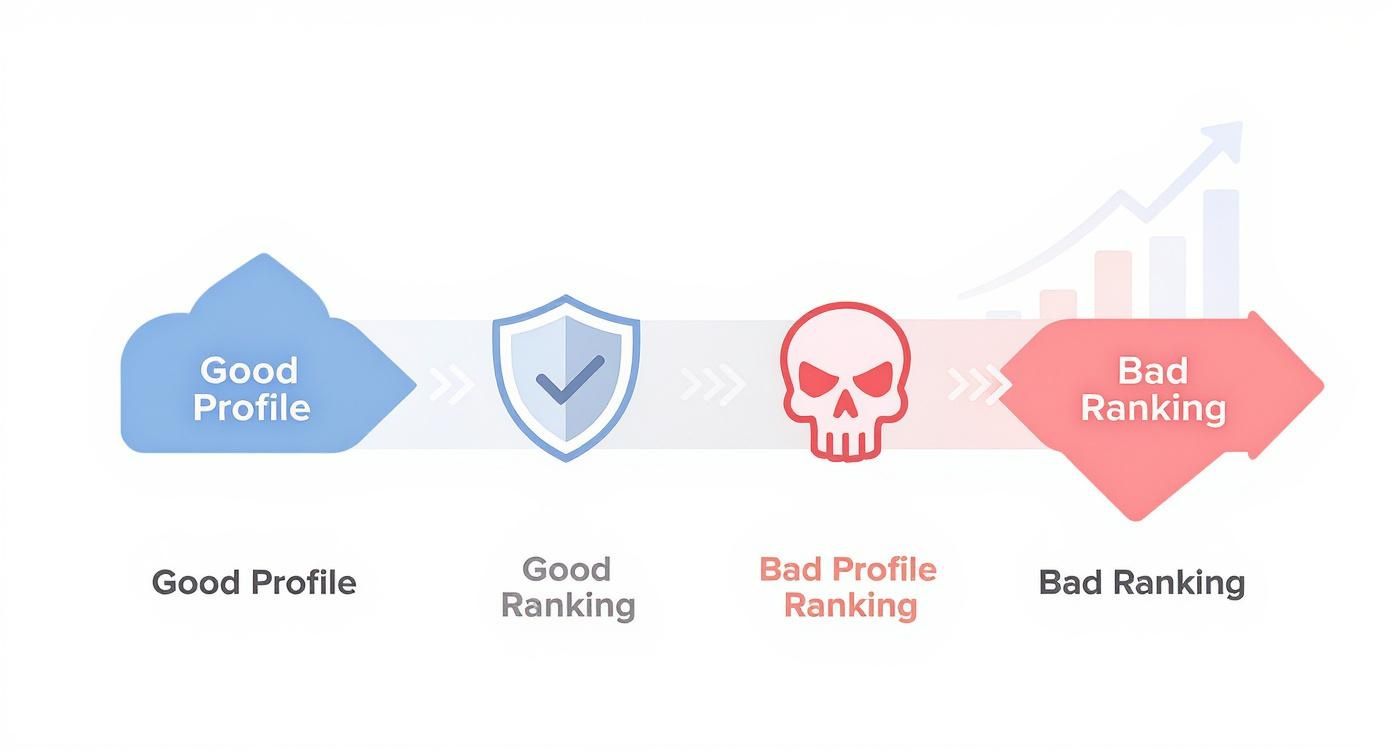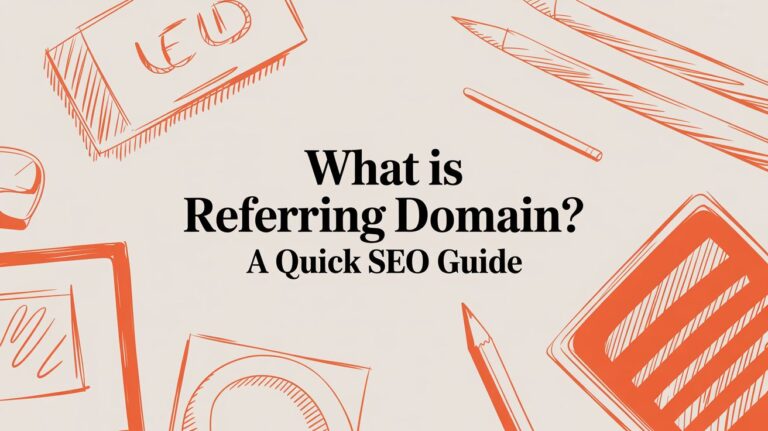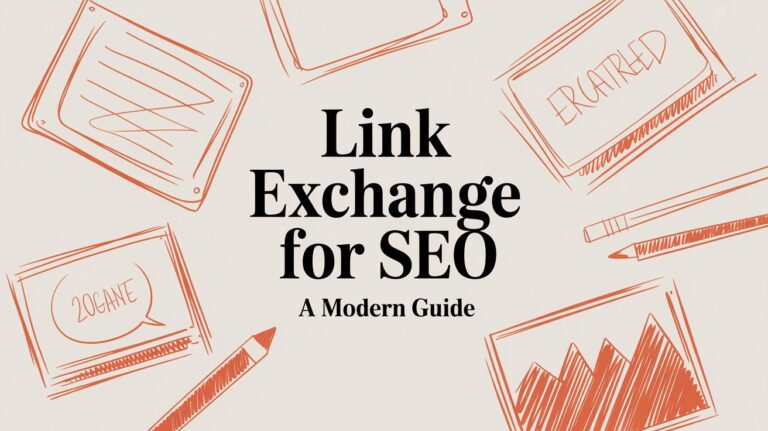what is a backlink profile: A Quick Guide to SEO
Ever wondered what search engines really think of your website? The answer lies in your backlink profile.
Simply put, a backlink profile is the collection of all links pointing to your site from other websites. But it’s more than a list. Think of it as your website’s digital reputation—a summary of every referral and vote of confidence it has ever received online.
Your Website’s Digital Reputation Explained

Imagine your website is a restaurant. A glowing review from a world-renowned food critic (like a link from Forbes or The New York Times) carries immense weight. It tells everyone—including Google—that you’re a top-tier establishment.
On the other hand, a mention on a new, unknown food blog is still good, but it doesn’t have the same impact. And a link from a spammy, irrelevant site? That’s like a recommendation from a business with a history of health code violations. It could damage your reputation.
Your backlink profile is the total of all these endorsements. It shows search engines how credible, authoritative, and trustworthy your website is. A strong profile filled with high-quality links can send your rankings soaring. A weak or toxic one can leave you buried on page ten. This is why understanding your backlink profile is the foundation of any serious SEO effort.
Why Your Backlink Profile Matters
The quality and quantity of your backlinks directly impact your website’s authority and visibility in search results. Managing your backlink profile is one of the most vital parts of modern SEO. Your profile is the evidence you present to search engines that your content is valuable and deserves to be seen.
A healthy profile leads to powerful outcomes:
- Higher Search Rankings: Authoritative links are a top ranking signal for Google.
- More Organic Traffic: Better rankings mean more people will discover your site.
- Stronger Credibility: Links from reputable sites build trust with search engines and visitors.
This digital reputation isn’t built overnight. It requires a strategic approach focused on earning quality endorsements, not just accumulating as many links as possible.
Monitoring your backlink profile is a fundamental piece of any real growth strategy. This work ensures your site builds the authority needed to attract visitors and turn them into customers.
The Anatomy of a Healthy Backlink Profile

To understand a backlink profile, you must know its core components. Think of it like a doctor checking vital signs. Search engines analyze key metrics in your profile to determine your website’s strength. A healthy profile is all about balance.
The first vital sign is the number of referring domains—the count of unique websites that link to you. Ten links from one website is nice, but one link each from ten different high-quality websites is far more powerful. It shows broader support for your content.
Diverse support tells Google your site is a widely trusted resource. Then there’s anchor text, the clickable text in a hyperlink. A natural anchor text profile has a healthy mix of your brand name, keywords, and generic phrases like “click here.” It reflects how real people link to useful content.
The Flow of Authority and Relevance
Not all links are created equal. The biggest distinction is between ‘dofollow’ and ‘nofollow’ links.
Imagine authority as water flowing through a pipe. A ‘dofollow’ link is an open pipe, letting “link juice” flow from the linking site to yours. These links directly boost your search rankings.
A ‘nofollow’ link is a pipe with a closed valve. It still sends traffic but includes a tag telling search engines not to pass authority. While not as powerful for SEO, a natural profile has a mix of both.
Another key element is link relevance. A link from a site in your industry is worth far more than one from a random niche. If you run a marketing blog, a backlink from a top marketing publication is a massive vote of confidence. A link from a pet grooming blog? Not so much.
A healthy backlink profile isn’t just a numbers game. It’s a balanced ecosystem where relevance, authority, and natural patterns build a strong digital reputation.
Measuring Strength and Momentum
Two final pieces complete the picture: authority and velocity.
Domain Authority (DA) is a score by Moz that predicts how well a website will rank. While not a direct Google metric, it’s a reliable proxy for a site’s strength. Earning links from high-DA sites is a core link-building goal.
Finally, link velocity is the speed at which you gain new backlinks. A steady increase in links over time looks natural to search engines. A sudden, massive spike can look suspicious and may trigger a penalty. Slow, consistent growth is the key to a powerful profile.
How Your Backlink Profile Shapes Your SEO Success
We’ve covered the “what.” Now for the “why it matters.” Your backlink profile is your website’s online reputation. It’s one of the most powerful signals you send to search engines, showing your credibility and authority.
When Google’s crawlers see many reputable and relevant sites linking to you, they see it as a vote of confidence. It’s like getting recommendations from top experts. This tells them your content is a trustworthy resource that deserves to be shown to more people.
The Direct Impact of a Strong Profile
A healthy backlink profile directly fuels your SEO performance, creating a powerful flywheel effect for growth.
Here’s how a great profile translates into real results:
- More Organic Traffic: High-quality links from authoritative domains boost your rankings, leading to more clicks and visitors.
- Better Keyword Rankings: Backlinks give you the authority to compete for high-value keywords that drive business.
- Faster Content Indexing: When a well-known site links to your content, search engine crawlers discover and index it faster.
A strong backlink profile doesn’t just improve your rankings—it validates your content’s authority, making you a serious contender in search results and helping you hit business goals.
The Dangers of a Toxic Profile
On the other hand, a bad backlink profile can be a disaster for your SEO. A collection of spammy, low-quality, or irrelevant links actively harms your site’s reputation and can lead to a Google penalty.
These toxic links are major red flags for search engines, signaling that you might be trying to manipulate the system. The result can be a steep drop in search visibility, causing organic traffic to disappear almost overnight.
Cleaning up a toxic profile is a painful, time-consuming process. That’s why focusing on link quality from day one is so important. A bad profile can undo months, or even years, of hard work.
A Step-by-Step Guide to Auditing Your Backlink Profile
Knowing what a backlink profile is in theory is one thing; analyzing your own is where the magic happens. A backlink audit is a regular health checkup for your website. It helps you spot potential issues before they become serious problems and find strengths to build upon.
Using SEO tools like Ahrefs or Semrush, you can perform a complete diagnostic to see where you stand. An audit isn’t a one-time task; it’s a routine. The goal is a data-driven picture of your referring domains, anchor text, and overall link quality. This is the first step toward building lasting authority.
This visual shows the direct connection between your backlink profile’s health and SEO success.

As you can see, a healthy profile sends the right signals to search engines, leading to better rankings. Conversely, a toxic profile can actively hurt your search performance.
Your Backlink Audit Checklist
A systematic approach is key. This checklist breaks down the audit into manageable steps, ensuring you cover all critical components of your profile.
| Audit Step | Key Metric to Analyze | Recommended Tool |
|---|---|---|
| 1. Gather Your Data | Export a complete list of backlinks and referring domains. | Ahrefs Site Explorer, Semrush Backlink Analytics |
| 2. Assess Referring Domains | Quality and quantity of unique linking websites (Domain Rating/Authority Score). | Ahrefs, Semrush, Moz |
| 3. Analyze Anchor Text | Distribution of branded, naked URL, and keyword-focused anchors. | Ahrefs, Semrush |
| 4. Check Link Attributes | Ratio of “dofollow” vs. “nofollow” links. | Most major SEO tools |
| 5. Evaluate Link Relevance | Contextual fit of the linking page and website. | Manual Review, Ahrefs |
| 6. Monitor Link Velocity | The rate at which you acquire new backlinks over time. | Ahrefs, Semrush |
| 7. Identify Toxic Links | Spot links from spammy, irrelevant, or low-quality sources. | Semrush Backlink Audit Tool, Ahrefs |
Following these steps provides a comprehensive view of your backlink profile, arming you with the insights needed for strategic improvements.
How to Spot and Flag Toxic Links
A crucial part of any audit is finding toxic links. These are digital deadweights—links from spammy, low-quality, or irrelevant websites that can harm your rankings.
Watch for these red flags:
- Links from sites in a foreign language with no connection to your content.
- Links from known link farms or private blog networks (PBNs).
- Links with over-optimized, unnatural anchor text.
- Links from websites with very low authority scores.
Staying on top of your backlink profile is essential. Consistent audits can significantly reduce the risk of an algorithmic penalty by helping you spot and remove toxic links early. In some cases, cleaning up just 5-10 toxic backlinks can lead to a 15-20% boost in rankings. For more insights, check out this guide on backlink profile analysis from Reporter Outreach.
Once you identify harmful links, you have two options. First, contact the site owner and request removal. If that fails, use Google’s Disavow Tool to tell the search engine to ignore them.
Building a Powerful Backlink Profile
After your audit, you have a clear map of your site’s current standing. It’s time to shift from defense to offense. The real work is building a backlink profile that impresses search engines and sends you engaged traffic.
This isn’t a numbers game. Forget chasing high link counts. A few authoritative links from respected, relevant sites will do more for your SEO than hundreds of junk links. The goal is a sustainable, white-hat strategy that grows your site’s credibility over the long term.
Create Content People Can’t Help But Link To
The foundation of any great link-building campaign is content so useful that other websites want to link to it. This is how you earn links naturally. Instead of just writing another blog post, create assets that solve real problems for your audience.
Consider developing assets like these:
- Original Research and Data: Conduct a survey or analyze industry trends to create a unique report. Fresh statistics are link magnets.
- Free Tools and Resources: Build a simple calculator, checklist, or template that helps your audience. Tools attract links by providing immediate value.
- Comprehensive Guides: Create the single best resource on a specific topic. A definitive guide will naturally accumulate links for years.
When you create something truly exceptional, the content does most of the link-building work for you.
Master the Art of Outreach and Relationships
Great content is just step one. If no one sees it, it won’t earn links. This is where strategic outreach comes in. This doesn’t mean spamming a generic email to a thousand websites. It means building real connections.
Start by identifying key players in your niche: top blogs, influential publications, and people with an audience. Before asking for a link, provide value. Share their content, leave thoughtful comments, and engage with them on social media.
When you reach out, personalize your message. Show you’ve read their work and explain why your resource would benefit their audience.
Guest blogging is another excellent way to earn a valuable backlink while tapping into an existing audience. It establishes your expertise and builds your profile. For advanced strategies, tiered link building can amplify the impact of every link you secure.
A powerful backlink profile is built on value and trust. Prioritize creating exceptional content and fostering authentic relationships to earn authoritative links that drive lasting SEO success.
Common Link Building Mistakes to Avoid
When building a backlink profile, what you don’t do is as important as what you do. It’s easy for good intentions to backfire, leading to strategies that hurt your site’s rankings. Avoiding these common mistakes is key to long-term success.
The most common mistake is chasing link quantity over quality. One authoritative link from a top-tier site in your industry is worth more than a hundred low-quality links. Focusing on numbers can lead to toxic backlinks and a Google penalty.
Another frequent error is aggressive anchor text optimization. Using your main target keyword for every link is a massive red flag to search engines. A natural profile has a mix of anchor text: your brand name, naked URLs (like “www.yoursite.com“), and generic phrases (“click here”).
The Dangers of Inconsistency and Irrelevance
You also need to monitor your link velocity—the speed at which you acquire new links. A sudden, unnatural spike in backlinks looks suspicious. Search engines prefer slow and steady growth, suggesting people are organically discovering your content over time.
Relevance is another crucial factor. A backlink from a website in your niche is a powerful endorsement. A link from a completely unrelated site carries almost no SEO weight and can look spammy.
A healthy backlink profile is earned, not manufactured. Every link should have a logical reason for being there and provide value to anyone who clicks it.
Finally, avoid outdated schemes like aggressive link exchanges. While strategic partnerships are valuable, formal reciprocal linking can be flagged by search algorithms. To collaborate safely, understand the right way to approach a link exchange for SEO and steer clear of penalties. Choose authentic, value-driven partnerships over risky shortcuts.
Backlink Profile FAQs: Your Questions Answered
Let’s cover a few common questions about backlink profiles. Getting these fundamentals right helps focus your link-building efforts where they matter most.
How Many Backlinks Do I Need?
This is the most common question, but it’s the wrong one. The real question isn’t “how many,” but “how good?” Quality will always beat quantity.
One strong link from a major, respected site in your industry is worth a hundred links from irrelevant websites. Some pages rank with just 5-10 excellent links. In competitive niches, you might need 40-50. Your goal is not the biggest backlink profile, but the most credible one.
What Happens If I Buy Backlinks?
Buying backlinks is a shortcut to an SEO disaster. It violates Google’s guidelines, and their algorithms are sophisticated at detecting paid link schemes.
The penalties are steep. Best case, Google ignores the links, and you’ve wasted your money. Worst case, you get a manual penalty that tanks your rankings and makes your organic traffic vanish. It’s a risk you can’t afford to take.
How Long Does Link Building Take to Show Results?
Building an authoritative backlink profile is a marathon, not a sprint. While you may see small improvements sooner, plan on a three to six month timeline to see a significant, lasting impact from your link-building efforts.
It takes time for search engines to crawl new links, evaluate their quality, and recalculate your site’s authority. The key is a steady, natural pace. Patience separates a flimsy strategy from a powerful, sustainable backlink profile that fuels long-term growth.
Ready to build a powerful backlink profile without the manual grind? BlazeHive uses AI to connect you with relevant websites in your niche, automating the entire process. Start earning high-quality backlinks today.







